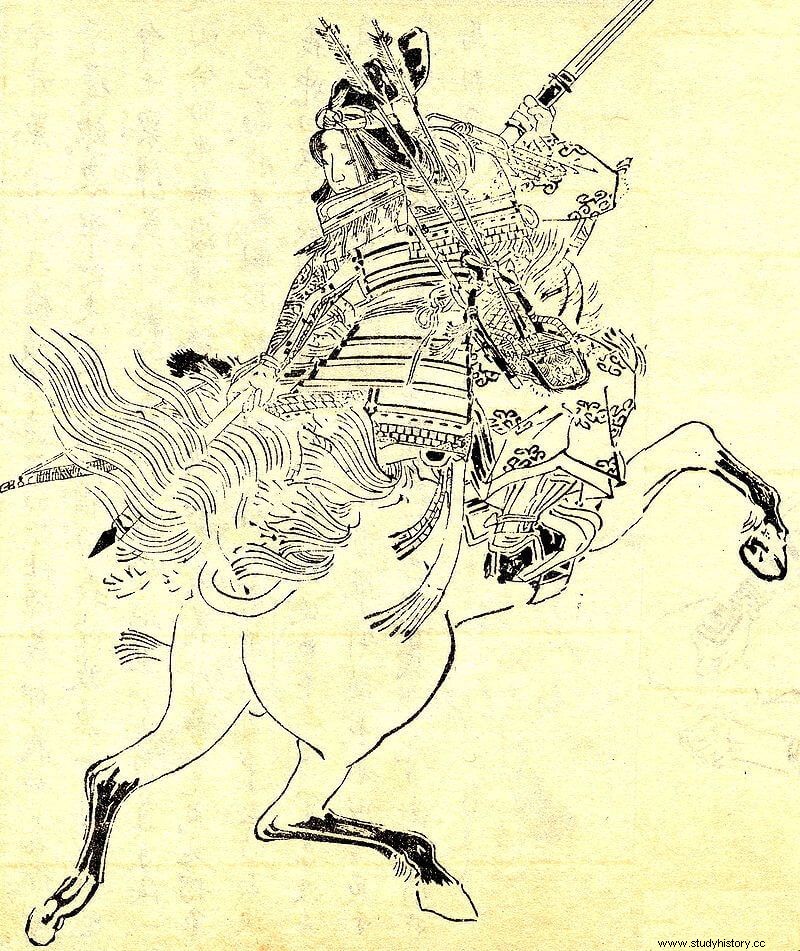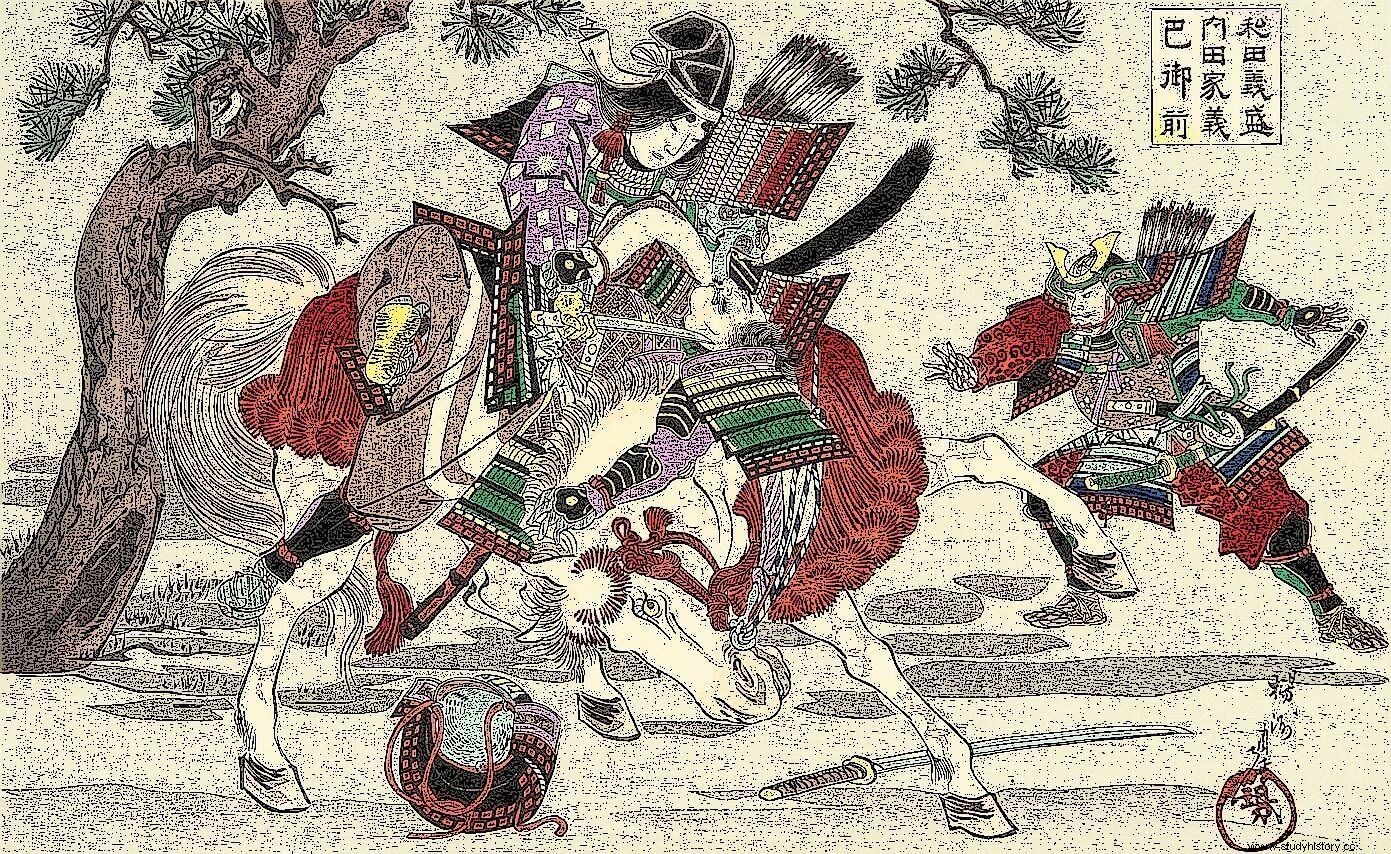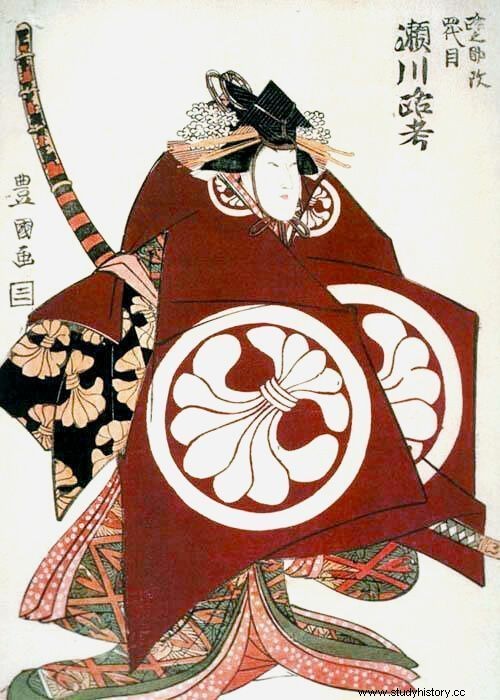In medieval Japan in the eleventh and twelfth centuries, the formal power of the emperor was only a shadow compared to the effective power of the powerful families and shoguns. Since the beginning of the 10th century, in the Heian era (794-1185), several of the samurai clans began to fight each other due to the weakness of the emperor, causing the outbreak of the Genpei wars (1180-1185).

In this war the clan fought Taira and the Minamoto clan , who supported different candidates for emperor. The war would begin with the defeat of Minamoto Yoritomo , but thanks to the alliance with the Takeda family he would achieve his victory and establish himself as the most powerful clan in Japan. As a participant of it is our protagonist:Tomoe Gozen (1157-1184?), an onna bugueisha that went down in history for the famous Heike Monogatari (Song of Heike) .
Tomoe Gozen and the samurai women
In it she was described as a woman:“especially beautiful, with white skin, long hair and beautiful features. She was also an excellent archer, and as a swordswoman she was a warrior worth a thousand, ready to confront a demon or a god, on horseback or on foot. When a battle was imminent, Yoshinaka would send her out as its first captain, equipped with heavy armor, a massive sword, and a mighty bow; and she was braver than any of her other warriors.” Tomoe Gozen was born into a samurai family and as such, she was educated in the martial art to protect it.
In front of the weapons used by the samurai (bokken, katana...), the samurai women were instructed in weapons such as the naginata or the bow, which allowed them to avoid the closest confrontation. When the time came, Tomoe joined the Genpei war alongside the Minamoto clan and her husband or lord, General Yoshinaka , cousin of the Minamoto leader. Tomoe led the troops to a decisive victory over the Taira clan at Kurikara Pass (1183), taking Kyoto , capital of Japan where the emperor resided.
Even so, the tensions between the cousins were evident:Yoshinaka did not accept that the territories that had belonged to his father passed to his cousin and Yorimoto Minamoto took the opportunity to accuse him of conspiracy, which which earned him to be declared an enemy of the state by the emperor. Yorimoto was thus able to confront his cousin and win the emperor's affection. After the capture of Kyoto, Yoshinaka was defeated by his cousins in the Battle of Awazu (1184), according to legend supported by her favourite, Tomoe Gozen, who tried to contain the enemy so that he could perform the seppuku .

The end of this warrior has been widely debated:in the Genpei Seisuiki it is said that she was defeated by Wada Yoshimori and forced to become his concubine. In other sources it is stated that she took her robes or that she managed to avenge the death of her lord by annihilating her enemies. Despite doubts about the veracity of her figure, the tomb of her assistant, Yamabuki Gozen , has been found. , which makes historians think that the events narrated in the Song of Heike could have historical truth.
Tomoe Gozen in popular culture
In Japan, the onna bugeisha Tomoe Gozen has not had the impact of other samurai women like Nakano Takeko , commemorated during the Aizu festival, but it does survive in the Japanese collective imagination. Thus, there is a theatrical piece nō titled Tomoe of the fifteenth century, and more implicitly the kabuki theater has also dedicated a play entitled Onna Shibaraku to her. of the eighteenth century. If she appears, it has also served as an inspiration for popular fantasy literature, such as the Tomoe Gozen trilogy. by Jessica Amanda Salmonson.

The manga genre has also used the figure of Tomoe in the series Samurai Deeper Kyo , in which different characters from Japanese history appeared and which gave rise to a video game and an anime issued by Studio DEEN. Some have found reminiscences of these legendary samurai women in the popular anime character Sailor Moon with a critique of Japanese society, but also a reflection of her collective imagination. In Nurarihyon no Mago Tomoe also appears as a figure in which the villain reincarnates. Works of little historical rigor, in fact, in the latter it is stated that Tomoe obtains a weapon from the Taira clan, when, as we have seen, she was fighting for the opposite side. In a similar but more childish way, our protagonist also appears with the name of Tomoe Ame in the comics Usagi Yojimbo . Finally, and of American creation, the science fiction series Riverworld also uses the character of Tomoe Gozen as an ancient warrior.
Despite its numerous interpretations, the figure of this samurai woman has not been treated with historical rigor but rather responding to the ideal of a warrior woman and samurai honor, normally related to love plots in which its beauty and sharpness stand out at the same time. Be that as it may, Tomoe Gozen went down in history for the legend of her in a war that meant the consolidation of power in the hands of the mononofu or samurai, a power that would only be eclipsed with the Meiji Restoration and subsequent exaltation of the emperor.
BIBLIOGRAPHY AND SOURCES
REYES FERRER, Maria. Women and power:queens, countesses, aristocrats and indomitable warriors. International magazine of cultures and literatures, ISSN-e 1885-3625, Nº1, 2014, pp. 286-312.
SOLUM, Terje. Samurai Saga:The Rise of the Takeda Clan. Wake up Ferro Editions, Madrid, 2015.
SICILIA CARDONA, Enrique. Myths and swords, paths and duties. The essence of samurai honor. Desperta Ferro Modern History Magazine No. 5, ISSN:2255-0542, pp. 48-51.
YOSHIKAWA, Eiji. The Song of Heike:The Great Japanese Medieval Epic. Satori Editions, 2014.
